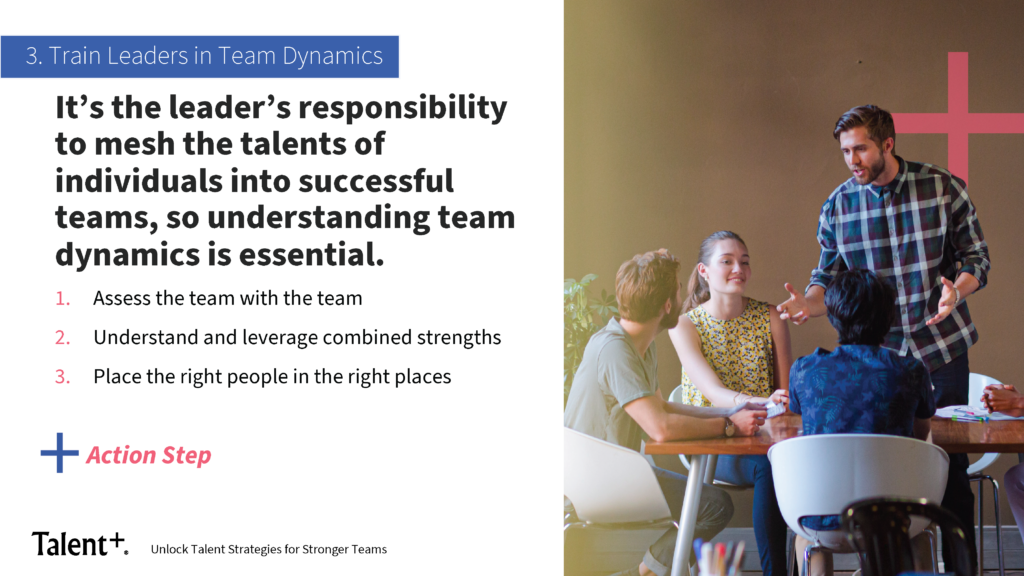
Building strong teams at work is a multi-faceted challenge. Fortunately, at Talent Plus, we’ve developed scientifically validated strategies to do just that.
In a recent webinar, Talent Plus Chief Growth Officer John Henley and Director of Leadership Analytics Scott C. Whiteford, Ph.D. delved into four essential strategies for building strong teams, taken from our recent white paper. They shared valuable insights and practical tips for leaders to enhance team dynamics and maximize individual strengths. Here are the key points they discussed during the webinar.
1. Understand the Leader’s Strengths
Understanding and leveraging a leader’s strengths forms the foundation of building strong teams, and it’s the core of our work at Talent Plus.

“It’s imperative when working with your leaders — or for the leaders themselves — to really understand their strengths and how to best utilize those,” says Whiteford.
Self-awareness is a mark of a true leader, comments Henley. Assessing their own areas of strength and weakness helps leaders be confident and humble at the same time, owning their true gifts and leaning on the rest of the team when necessary. “It’s a real first step in a leadership journey,” says Henley.
Once you understand a leader’s strengths, organizations should pair talented leaders with talented employees. In reality, a perceived bad hire often results from a bad match between the leader and the people they are leading.
“If you bring somebody in with really strong talent, they need to see that there’s lots of talent around them,” advises Henley.
To understand the leader and their team members’ individual strengths, ask each of them to complete a thorough talent assessment, starting with the leader and the key people around them. This will help you (and them) understand the intensity of their strengths and identify any hidden strengths they’re not actively using.
2. Personalize the Leader’s Approach to Team Members
The next step is to tailor a leader’s approach to each team member. Even on a great team, high-talent employees need leaders who invest and develop them as unique individuals.

This step is not just about understanding your team members’ strengths but developing them as well — starting with the highest performers. Just like a basketball team, talented players are most successful when they’re in the right role.
“How do you individualize your leadership to each member of your team?” cautions Whiteford. “In general this is where leadership development seems to stop. Yet it’s essential for building a stronger team.”
Another important aspect of personalized leadership is listening to each individual’s goals, desires and motivations. Ask them what they want out of their career and the job they’re doing now, says Whiteford. “By understanding their individual motivations, career needs and job needs, the leader’s responsibility is to help them reach those goals through the position they’re in.”
This is a two-way street. The leader and team member should communicate honestly and transparently about the team member’s goals, what they can do to get the most out of their job, and what the leader can do to tailor the job to the team member. Most importantly, ensure the goals discussed in these development conversations include measurable outcomes.
Leaders can start developing a personalized approach by holding one-on-one Career Investment Discussions (CIDs) with each member of their team. Ask, “What is your vision of your career? What is your vision within the job? What do you want to get out of this role?” Then think of ways that you, the leader, can help them reach those goals individually and with the team as a whole.
3. Recognize Team Dynamics
Training your leader in team dynamics is essential to strong teams. Leaders will use information about each team member and then see how they all interact with each other on the team.

This step starts with the team and their leader assessing the team together to help them understand where their strengths lie and how to best utilize those strengths. There are over 3 million different combinations of top 10 talent themes. This enormous number of possible combinations means each individual and leader is extremely unique — and the larger team exponentially so.
First, understand the team’s strengths in an aggregated, grid-like format. What are each individual’s strengths, and how can you utilize them?
“Look at a grid of strengths to really understand who is best at what and how can we put them in the places to succeed as a team,” advises Whiteford. “They’re all going to be different, but we’re going to see similarities across the team.”
This exercise will help leaders identify strengths that the entire team has in common. For example, imagine a team with a strong response to negativity. Any team member without this strength may find it challenging to be on the same page as the rest of the team.
The next step is to assess the gaps in your team’s strengths. Recognizing softer areas can help you fill gaps with other people who have strengths in those areas. For example, you can fill your social gatherings with team members who enjoy meeting and mingling with new people while allowing others to nurture one-on-one relationships.
You can use a Talent Grid to understand who’s strong where, who’s softer in which areas and how you can build compensatory strategies for those softer areas.
4. Understand the Team
Finally, leaders must understand their teams to truly succeed. This is critical but the least leveraged of all team strategies.

Leaders should understand how the team feels about the team itself, their leadership, communication, the broader organization and their team’s future potential. Then, assess the gap between where the team is now and where the team should be — based on the team’s feedback.
“This way the leader can continue to grow the team and see market improvement with the individuals on the team,” says Whiteford.
The attitudes and perceptions of team members are the most challenging but also the most important aspect of understanding a team. Whereas many organizations focus on engagement and satisfaction surveys broken out by team, this doesn’t take into account each team’s concept of their own gaps. Rather, this approach only accounts for where the team stands compared with other teams.
Instead of comparing teams to each other within an organization, it’s much more effective to compare a team’s performance to the team’s desired performance. Ask questions like “Where are you now with communication? Where would like to be?”
The team should determine the benchmark. Then, the team can create goals and initiatives together to close those gaps. This activity guilds camaraderie and trust because the leader is not determining benchmarks and creating goals in isolation — rather, the whole team is part of the solution.
“This is an ongoing journey to build a healthy, thriving team,” says Henley.
Assessing the gaps on your team can be accomplished at scale with Talent Plus’ TeamView solution which measures different attitudes with 42 questions on a scale of one to seven.
Succeed With Stronger Teams
Building strong teams requires a comprehensive approach that encompasses assessing individual strengths, fostering open conversations, leveraging team dynamics and understanding team perceptions. By implementing these four key components, leaders can create a cohesive and high-performing team.
As Seth Godin aptly stated, the success of organizations lies in the intangible attitudes, processes, and perceptions of the people who do the work. By prioritizing these aspects, leaders can build trust and genuine relationships that unlock the full potential of their teams and drive long-term success.
For more insights, watch our full webinar on strategies to build stronger teams.
Talent Plus
Talent Plus is a team of industry experts who collaborate to deliver insightful and impactful content. Our blogs are designed to provide practical advice and fresh perspectives, helping you stay informed and ahead of the curve.
Latest Posts: Blog

Blog November 04, 2025
Top Performers, Explained: Karl Giuseffi’s Blueprint to Thrive
Explore insights from Karl Giuseffi on how talent science enhances workplace success and team performance.
Read More
Blog October 22, 2025
Practical Ways to Give Feedback That Strengthens Talent and Growth
Learn how to give good feedback that inspires and builds trust among your team while enhancing their natural strengths.
Read More
Blog September 25, 2025
What Do We Really Mean When We Talk About Talent?
Unlock the secrets of talent in the workforce. Learn how to identify inherent abilities for excellence in your team.
Read More
Blog July 08, 2025
How to Manage Difficult People
Master how to manage difficult people at work with six effective strategies for maintaining productivity and engagement.
Read More
Selection April 28, 2025
The Science of Talent Reduces Turnover in Credit Unions
Learn how Credit Unions use Talent Plus Solutions to decrease turnover, better engage employees and increase performance.
Read More
Blog April 25, 2025
Building a Better Healthcare Team: Nebraska Spine Hospital’s Data-Driven Talent Approach
Find out how Nebraska Spine Hospital partners with Talent Plus to enhance employee engagement and organizational culture.
Read More

